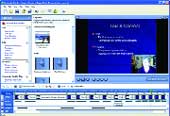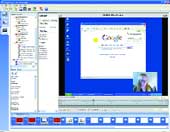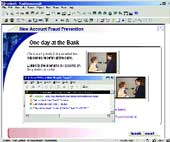Education software is one of the more complicated technologies to review. The topic is so broad and the tools are so extensive that finding the best program for your agency can be difficult.As is true in most disciplines, the best tools of the trade are versatile. There are some instructional programs that are essential to any education tool chest, whether you're doing corporate training, e-learning or working in a classroom. Whether you are training your agency's employees to use a new phone or payroll system or giving a general overview of security protocols, these programs can help you explain things clearly and concisely.To help choose the best education tools for your agency, we focused on theprograms most commonly used by instructional technologists. Instructional technology is a relatively new profession and a subset of education that uses programs to build and access the methods and resources for learning. Instructional technologists evaluate the teaching approaches from two standpoints: Theory and audiovisual programs. This review examines audiovisual technologies.We graded on the basis of performance, ease of use, functionality and price of each solution. Another consideration we felt was necessary in this review is overall importance. This score is a quick measurement of how important a program is, or has become, to the overall instructional technology market. Although this did not contribute to the final scores, a product with a high grade in this area is one you will almost certainly encounter.Additionally, after using each tool with a database of information to play with, we asked the big question to determine the final grade: Would agency performance improve if we used this software to help train and educate employees?We examined four of the leading education tools on the market. There are several others that should be included, but we had limited editorial space, and time constraints kept many of the vendors from meeting our deadlines for product submission.We specifically wanted to include Adobe Systems' Authorware, but their public relations staff did not return repeated calls and e-mail messages. It's also important to note that audiovisual technology is a broad category. Many of these programs were initially geared toward the consumer market but are being adopted by professionals in the public and private sectors. B B+ A A+ A Easy to learn and use ' and free. Limited interoperability with other Microsoft programs.Microsoft Photo Story 3 is a perfect example of a consumer tool that is taking precedence in instructional and professional settings. Photo Story, available at no charge (GCN.com/777), is a simple tool that helps create video stories by adding panning and zooming effects to still images. Photo Story is, in effect, a crude motion-picture tool that also lets you record narration for your images, add titles and include background audio similar to a short film.This simple software can greatly enhance PowerPoint slides. I have used Photo Story in corporate settings to get my point across, and I have seen Photo Story used to illustrate complex financial models. At the University of Houston, Photo Story is included in an instructional-technology class focusing on the use of moving images to improve communication.The main attributes that make Photo Story so effective are the panning and zooming features. They let you show an audience a complete image and then focus on a particular area of interest. Likewise, Photo Story comes with an array of image-editing abilities and effects, so you don't have to use a second program to prepare your images.Photo Story's simple-to-use and logically constructed interface is perhaps its best quality ' next to its price. The program is essentially a large wizard built around a timeline of uploaded images.Above this timeline is a small image of each picture with symbols attached to signify an edited image or a section of the presentation that contains an audio file. At the top of this window is a section where you can record audio and narration or type in notes and preview the file. The preview option is interesting because it shows you the file from start to finish in a separate, smaller window ' unlike PowerPoint, where the preview takes up the entire screen.Photo Story is capable of saving your presentation at resolutions as low as 160 by 120 pixels or as high as 1,024 by 768. This lets you play your file as a Windows media video on players as small as Smartphones with Windows Media Player 10 Mobile, to desktop computers with a standard version of Windows Media Player.One issue we have with the software is that it can only play through Windows Media Player, and you can only save files as .wmv or .wp3.However, you can still create video CDs or DVDs by importing your presentation into a VCD or DVD authoring program that supports WMV files, then using that program to burn a VCD or a DVD.The program also suffers from insufficient interoperability with Microsoft Office programs.For example, the ability to archive Photo Story files through an Access interface would be useful to an agency with an active training department. Likewise, a more seamless integration with PowerPoint would enhance Photo Story's potential in the workspace.Microsoft, Redmond, Wash., (800) 765-7768, www.microsoft.com A A+ B A A Creates screencasts with multiple formats. Not Mac-compatible.[IMGCAP(2)]If you have ever tried to capture an image, screen shot or video on your computer and then tried to share that file with someone, you understand the frustration of incompatible formats.TechSmithCamtasia Studio 4 records exactly what you see on your computer screen and lets you edit and share content online using a multitude of popular multimedia formats. Users can also import video from digital camcorders, and common digital video formats such as AVI, MPEG, MPG and WMV.But for all its versatility with media formats, Camtasia operates only on Windows platforms, including Vista. The fact that a multimedia tool isn't at least Mac-compatible is depressing, particularly because Camtasia would be perfect for a Mac OS.It's a world apart from its Mac counterpart, SnapzPro, particularly in editing features.That aside, Camtasia is a lot more than just a capturing tool. Using Camtasia, an instructor could not only capture a PowerPoint demonstration but also produce tutorials, online lectures and podcasts. Likewise, an instructor could use Camtasia to include call-outs or quizzes in the middle of the captured video.Camtasia can create multiple simultaneous files so users can make a screencast of a captured video in a variety of formats, such as iPod, MP3 or PowerPoint.Likewise, the new version of Camtasia offers a 30-second preview that will let a user see how a video looks and sounds before producing the entire video.Camtasia also complies with Section 508 of the Rehabilitation Act. It comes with closed-captioning options so a user can synch voice narration with text displayed on the screen. Additionally, the latest edition puts a lot of focus on enhancing the audio options, including the ability to remove ambient noise and stabilize volume variations with the click of an icon.Perhaps the most important aspect of the software is how easy it is to learn. In 15 minutes and with no prior training on the software, I created an audio and visual demonstration of how to clear your computer's cache memory.The software works, literally, like a camcorder. At start-up, I chose for Camtasia to record my entire screen, and then I plugged in my microphone and clicked on the record button. I orally described the steps needed to clear the cache while I performed the function. When I was done, I hit the stop button and that was it ' I had made my first instructional video. Using Screencast.com, I could have uploaded that video for others to see and use.If anything, Camtaisia taught me in minutes that the most important part of any instructional software is content and planning.At $300, Camtasia is a little on the expensive side, but it's worth every penny. The simple-to-use interface and well-constructed wizards enhance its operability and the user experience. This software is easily one of the most crucial must-haves in the education field.TechSmith, Okemos, Mich., (517) 381-2300, www.techsmith.com A- B+ B B- A Zooming timeline and streamlined editing. Expensive.One of the most challenging aspects of instructional or educational testing is ensuring that your audience is learning what you are trying to teach. This typically requires a lot of professional observation and lab testing, which equates to a lot of money and time.TechSmith tries to simplify the process with Morae, which digitally conducts user experience research. Morae lets instructors set up a usability lab using simple webcams and the Morae 1.3 software.You place a subject in front of a computer with a webcam and a microphone. Then any number of usability testers or instructors can monitor the subject to see if they are able to perform whatever task you have taught them.For example, using Camtasia, I created a video demonstration on how to clear cache memory.Using Morae, you can monitor someone who has watched the tutorial as they attempt to clear the cache from their computer. Morae lets you not only see their reactions but also understand where they went wrong and what they may not have understood from the instructions.Morae also lets the usability testers edit footage not pertinent to their tests and focus on parts that highlight positives or negatives of the test. Likewise, Morae has a zooming timeline capability that lets usability testers zoom into specific moments on multihour timelines.The editing features of Morae are what set it apart. Users can splice clips and edit picture-in-picture footage to create highlight video. You can also personalize clips with logos, images or graphics, which makes Morae perfect for an agency with a small to midsize instructional base.It's important to note that although Morae works well and is effective, it becomes less effective with larger installations and usability studies. It's perfect for a small agency but not robust enough for large departments or multiple studies. And at $1,495, Morae is among the more expensive tools in this roundup.TechSmith, Okemos, Mich., (517) 381-2300, www.techsmith.com A- A- B B A Can help deliver online courseware and simulate software for training. Expensive, requires a lot of user training.It isn't often that I say a program with a retail price of $2,236 (GSA price of $1,956), is a bargain, but SumTotal Systems' ToolBook Instructor is worth almost every penny.ToolBook lets you develop and deliver online courseware in addition to simulations for skills training and certification.The program can perform software application simulations, so you can train employees on the use of any software program without endangering your agency. ToolBook provides realistic content that incorporates interactive options to help employees apply the learning to their day-to-day jobs to increase their competence and productivity.The problem with most simulation programs is complexity and the time it takes to build and execute a simulation.One of the best features of ToolBook Instructor is its logically constructed environment, which significantly reduces the time it takes to create an effective software application simulation.With ToolBook Instructor, authors can quickly develop effective, interactive simulations that automatically assess and record user performance using two standards and specifications for Web-based e-learning, the Sharable Content Object Reference Model and standards from the Aviation Industry Computer-Based Training Committee. ToolBook's Web-based simulations can be deployed in a number of demonstration, practice or assessment modes.Universal compliance is a crucial element of a robust education simulation tool. ToolBook supports a host of important industry standards, including the protocols developed by organizations such as Advanced Distributed Learning, the Institute of Electrical and Electronics Engineers, and IMS Global Learning Consortium.ToolBook also supports metadata tagging and data tracking and can be deployed on several open-standards-based learning management systems.To understand how well your audience is learning your material, quantitative feedback is crucial to discovering strengths and weaknesses of your simulations. Therefore, interactive content makes learning an important process, providing continuous feedback to measure the learner's level of success with the content. ToolBook Instructor allows teachers to make courseware more effective by easily incorporating multimedia elements.Despite being user-friendly, ToolBook Instructor has so many capabilities that it can be overwhelming to learn.For example, I had to spend two weeks with the program before I learned how to use the Action Editor, a visual programming tool with which you can create interactive courses without using OpenScript, the ToolBook programming language.This is an important feature that isn't even mentioned until Chapter 16 of the 600-page instruction manual.Nevertheless, Toolbook remains one of the best simulation and authoring programs when you need to simulate running another program, and as such, it is well worth the money and time invested by instructors.SumTotal Systems, Mountain View, Calif., (866) 768-6825, www.sumtotalsystems.com












